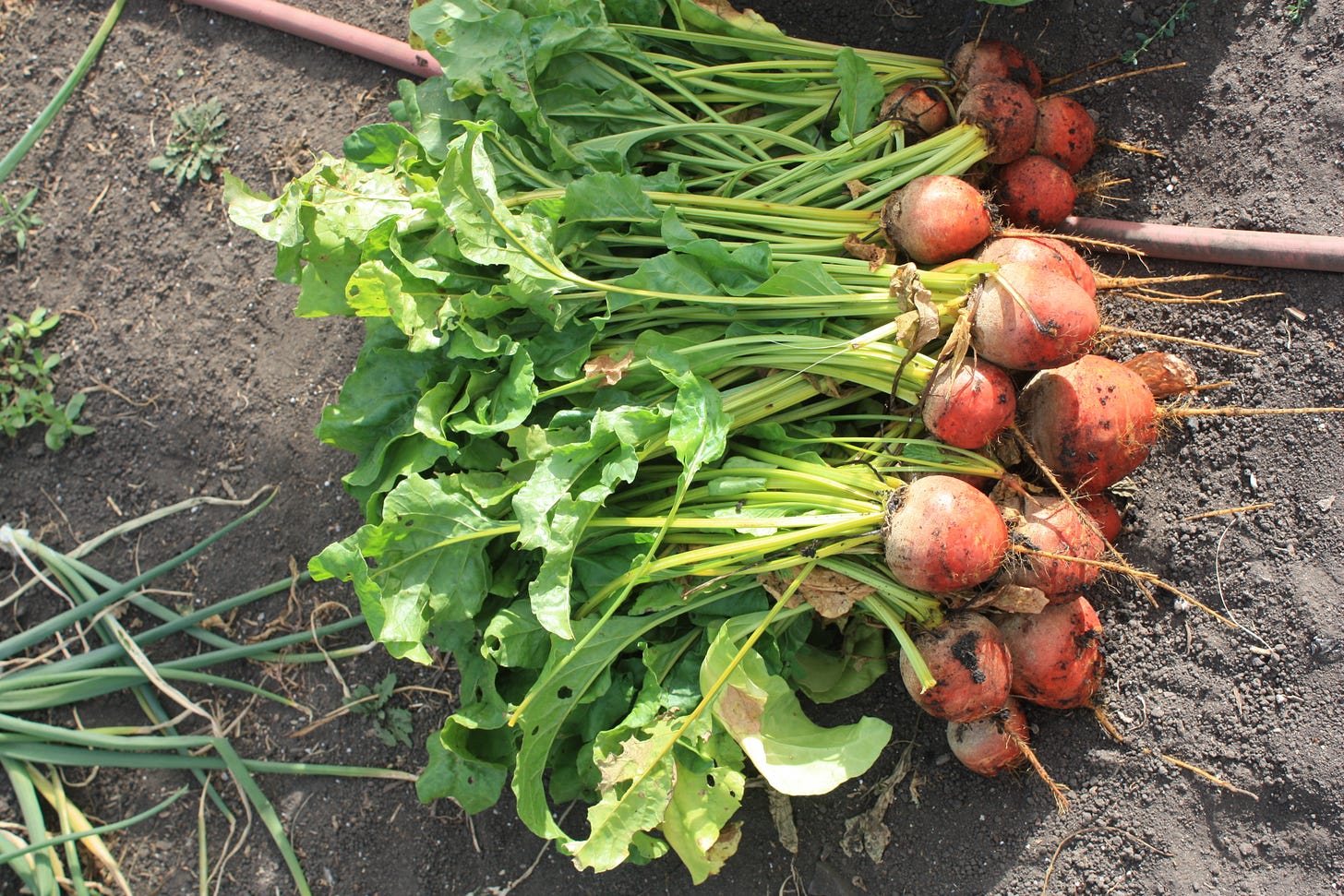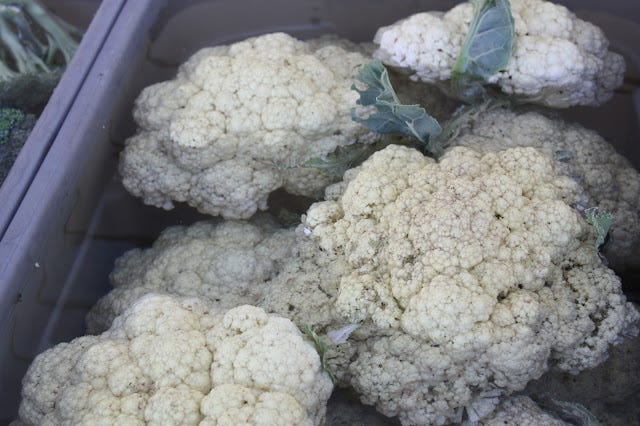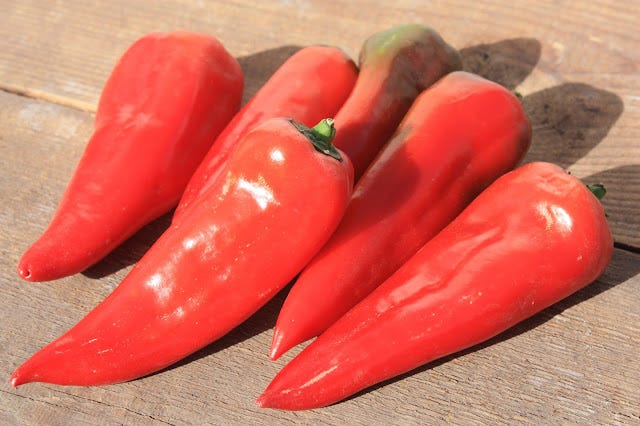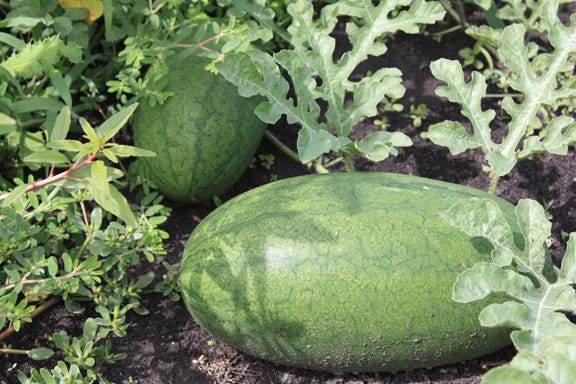I have had the privilege to talk about local foods in many places. Sometimes these presentations focus on how things were grown. Other times, it is about marketing and getting local food to local people and businesses. Often, it’s about specific topics like heirloom varieties or food in the schools. And, every so often, it is about getting people to eat better.
Of course, I made no pretense about being well-versed in the details that dieticians and other professionals might have. But I certainly can share some useful information and perspective that might be useful to them - and maybe to you - when it comes to figuring out ways to eat more fruits and vegetables.
Picky Eaters - Not so Anonymous
One thing I actually know a bit about is the struggle to get a picky eater to eat vegetables. So, of course, that topic always seems to come up as part of these presentation. I figure if I could eventually find my way to eating more fruits and vegetables, then others can as well!
Many of the fine people in the Cedar Valley who know the Genuine Faux Farm probably don't know Rob in any other context other than in his role as a small-scale, diversified farmer. If you are from the area and you haven't done much reading of this blog, you have probably made some erroneous assumptions. For example, a vegetable farmer has to be someone who has ALWAYS loved vegetables. Therefore, Rob has always loved ALL vegetables and must have no idea how hard it might be for a person to eat more veggies.
Let’s be honest here. Many people who have any familiarity with gardening and growing veggies kind of expect that those tending the garden will snack on a carrot or cherry tomato or radish.
That’s not me.
I am sorry to burst your bubble - but my parents can assure you that the list of things I would eat when I was growing up could probably fit on a 3"x5" card. When it came to veggies it had to be green beans, lima beans, peas, corn and potatoes (no lumps - thank you very much!). Tomatoes would be ok if it was a cooked sauce with very little evidence of skin or chunks of tomato.
Visiting someone during meal-time was fraught with peril because I would have to figure out how to not eat things I didn’t like without offending them. And, ordering things at a restaurant could be a chore. For example, sub sandwich shops always assumed you wanted a whole heap of shredded lettuce without even asking. Ugh!
My college friends encouraged me to get the mixed vegetables to watch me quickly and efficiently root out the carrot squares. I could eat my mixed veggies as fast as anyone else and not eat a single one of those icky, orange things. As a matter of fact, I could make small towers out of those carrot squares while successfully eating the beans, corn and limas out of the mix.
That’s a sign of a veteran picky eater - efficiency and artistry in avoidance.
Getting a Picky Eater to … Eat
First, I think we need to recognize where some of the roots of picky eating come from. Some of it comes from genetics and some from environmental factors, such as exposure to certain foods and modeling by adults. This interesting article in the Smithsonian Magazine suggests that some of our taste does change as we get older AND we can do some things to teach ourselves to alter our perceptions of some tastes.
On the other hand, changing eating habits isn’t as simple as aging and forcing ouselves to change. There are definite differences in taste from person to person. Some people are “supertasters” and will have problems with strongly flavored foods. Other people’s bodies may not react well to other foods.
The last thing to consider is that eating food often involves more than one of the senses. Touch, smell and sight often get into the act too. There are many foods where the texture sets off an alarm in a person’s throat that makes it close and say, “Nope, we’re not letting that go any further. You can just spit that right back out!” And I am sure that certain smells and visual clues can convince us not to consider trying out the taste part of the senses.
Fianlly, let’s face it. In a world where so many things are out of our control, it is relatively easy to decide WHAT you will eat. So, for some people, this is also a way of exercising some autonomy when they might feel they have very little power anywhere else.
Can’t Beet This
I do eat many more things than I used to. But, is it true that I like each and every vegetable that we have grown at our farm? No, of course not. I very much like many of them, I kind of like others and tolerate still others. I still have no tolerance for some foods. The only difference there is that I have learned how to make less of a stink about it when they show up. I pick them out or politely decline and go about my business.
Perhaps I grew up a little bit and found ways to learn how to eat some foods. Maybe the taste buds changed some. But, both Tammy and I are pretty certain that a big part of it had to do with the fact that we started growing our own produce. The quality and freshness have much to do with flavor and texture quality. And, of course, if you put some of your own effort into growing it, you might be more willing to try it
But there is more to it than that.
We have learned that different varieties of a vegetable type can have very different tastes and textures. Some people might not be able to detect a difference and others who do not initially find a difference eventually recognize that difference over time. In my case, I can often detect a difference in taste between different varieties quickly.
I had always found the earthy taste and slippery/slimy texture of the standard red beet to be - shall we say - choke worthy. Please, if you like boiled red beets, do not take offense. We know some people love them and happily prepare them by boiling them. Good for you! That’s why we grew red beets on our farm - so people could enjoy them the way they wanted to enjoy them!
But, we’ve learned there are several veggies that inspire a decided split between those who like them and those who classify that vegetable as an “evil” addition to the CSA farm shares we used to offer. Beets are one such vegetable.
Since we were already aware that veggie varieties can make a difference for taste, we tried a striped beet (Chioggia) and a golden beet (Touchstone Gold) many years ago. And, since I take my job seriously, I had to taste what we grow. I don't have to like each thing, as long as others do. But, I feel like I have to be able to say that I tried it.
In any event, I tried these beets with MUCH TREPIDATION.
We roasted some Chioggia's and found them to be less earthy and to have a pleasing texture when roasted. Then we tried Golden beets and I found I really liked those. As a matter of fact, I liked them when they were prepared numerous different ways! Then, I found I could eat red beats if they were roasted. But, I still don’t care for them boiled, but I can eat them (if I must).
On the other hand, I absolutely WILL draw the line on pickled beets. Doesn’t matter the variety, place or situation.
So what did we learn?
The two keys were vegetable variety AND preparation method.
Opinions About Onions
If I recall correctly, my father has always liked onions, but they don't always like him. At least, that's how he put it. I have not always liked onions and I think I inherited the part about raw onions not liking me so much too.
However, we've learned that the shorter season white onions and sweet yellows tend to agree with me more. They sautee up nicely and have a pleasant taste. On the other hand, storage onions tend to disagree with me more. Happily, if they are sauteed longer, they "sweeten up" and give me less troubles. As long as I limit the amounts and include enough of other things, I am usually just fine.
I really like the taste of red onions, as long as they aren’t too sharp (Redwing has been a good one for me). I prefer the taste of sweet onions like Ailsa Craig or Walla Walla. And I have found that New York Early are pretty good, in my opinion, for a yellow.
Onions are a bit of an oddity for me because I've always liked the smell of them (raw or cooked) and haven’t always appreciated the texture they brought to sauces. I will admit that I have taught myself to adjust my opinion of onions. It isn't so much that MY tastes have changed dramatically. But my willingness to figure out how to make things work for my preferences (and my digestive requirements) have improved.
It's Not CauliFLOUR
Tammy and I were given the impression when we first started gardening that cauliflower was a near impossible veggie to grow. And, sadly, when we would try cauliflower from the store, my first impression was that it tasted a bit like 'flour.' Yick.
Tammy got me to try more broccoli and cauliflower by adding cheese to the mix. That was great, but probably not the best long-term solution if you want your spouse to eat healthier. This was especially true if the volume of cheese was greater than the volume of the vegetable on my plate. However, as we added fresh broccoli and cauliflower from our own garden, I found less reason for the cheese.
As far as preparation goes, we still tend to prepare our cauliflower steamed or eat it raw with a dipping sauce of our choice. Cauliflower will occasionally appear in soup as well. We've added roasting to the list of options, though I admit I don't like broccoli, cauliflower and romanesco roasted as much as I do steamed. And, yes, I do like to have some real butter with these veggies.
And no, I don’t use a whole tub of butter for each floret.
This seems like a good time to remind you and me of something. Many people extol the virtues of roasting these veggies. That's great! If this is the method of preparation that you and yours really enjoy, go for it! Just remember that each person may have different preferences for preparation options - and that's ok. You like them roasted. I like them steamed. They like them raw. This person likes them with cheese and that person with butter.
The key is… they’re eating vegetables.
We've explored different cauliflower varieties and found some range of taste. But, it is my belief that soil and growing conditions can change the taste of this vegetable as much as anything. I appreciate a head of cauliflower from our farm and not really be impressed with the same variety from another source. I also feel that cauliflower in the late Fall has better taste - especially if it has experienced a frost. But, I have no proof of that. It’s pretty difficult to do a taste test side-by-side of an August harvest cauliflower and a late September harvest.
Unless you have a time machine.
Sometimes it has nothing to do with taste
Tammy likes to eat peppers raw in the field. I like the smell of peppers in the field and I am quite happy to pick her a pepper and toss it to her if she wants to snack on one. In fact, I will toss snack tomatoes or peppers to anyone if they indicate they might like one. But, you will rarely, if ever, see me crunch into one of these during a work break.
This has nothing to do with liking or not liking how they taste and everything to do with how they sit in my stomach. Remember, I do a good deal of stooping, getting up and down and moving around when I am outside at the farm. The last thing I want is to feel like I've got a rock in my stomach while I am stooped over. Sadly, that's what happens when I eat most raw peppers without something else to accompany it.
I am not alone in this phenomenon. Many people prefer red peppers because some of the things that cause discomfort are less prevalent in the more mature fruits. I also prefer peppers that are not bells as they also give me fewer issues. And, of course, if they are cooked, they seem to be easier to deal with.
In the end, I'm just happy to have a couple of smaller slices on a sandwich and a nibble or two here or there. But, since I won't eat too many peppers, I tend to be much pickier about the taste. If I only get a little bit of a pepper, it had better be a good pepper!
And - It needs to be ripe!
Then, there is the issue of ripeness. When I was growing up, I could tolerate certain kinds of melons, but I was never all that impressed with them. In fact, this is something I have heard from many people.
I try to remind myself of how I USED to feel about melons before we started growing our own melons. But, it gets harder and harder to do. Why? Well, it has been many years now since I have been forced to eat a melon that was NOT RIPE when it was harvested. Most melon varieties will taste like a lot of nothing if they are harvested early. And yet, that's what has been done for most grocery store melons. They are harvested before they are ripe so they won't split in transit to the grocery store.
Shipping tolerance over taste. Sadly, that is how most people are introduced to melons.
So, we sympathize with your opinion about melons. In fact, we understand why you feel the way you do. Some of you may not like the texture - so that may rule you out anyway and we can respect that. But, for those of you that thought: "Melons.... meh."
You need to try some of the heirloom varieties that we have grown when they are truly ripe! You might be so shocked by the taste initially that you might be tempted to decide you don't like it. But, give yourself a second taste and you'll realize that your initial reaction was because your brain was telling your tastebuds that they shouldn't detect that much taste in a melon.
We have noticed that some varieties have less taste if we get a heavy rain within a week of harvesting, which may be due to intake of moisture by the plant. And, yes, we have also noticed that the quality of taste can vary from one fruit (from the same variety) to another. And, a sad truth is that many melons taste best just when they’ve split open - which makes it very hard to market!
Our favorite melons for taste include Ha’Ogen, Eden’s Gem and Hearts of Gold. But, we’ll happily dig into a Pride of Wisconsin or an Oka, among many other varieties.
Are You Ready to Discover Tastes You've Been Missing?
I am still a picky eater and I always will be. As such, I respect your right to decide what you will and will not eat - for whatever reasons you select. But if you're looking to make some changes consider these thoughts:
1. Personal investment encourages attempts to try
In my case, it was the process of growing a vegetable and trying to figure out which varieties to grow. The investment grew when we opted to grow veggies commercially and offer them to others. I wanted to be able to tell people about the things we offered - and do it well.
You, of course, don't have to go that far overboard. Your investment could be a couple of plants in your garden or the support you give to a local grower of food. Or maybe you agree to research and fix a dish for friends and family that like this particular thing?
2. Reward yourself with the best examples of the thing you're going to try
Get the freshest, the ripest, and the best specimens you can get of whatever it is you want to try. So many people have stories of being turned off of a particular food because they were served some of the worst examples of that product at the point it was introduced.
The unripe melon. The out of season tomato. The old, wilted spinach from the back of the crisper. None of these are likely to make you a fan.
3. Try each thing with more than one variety and using more than one method of preparation over time.
One of the keys here is to take your time with it. The other key is to persist with the process of exploration over time. To expect success on your first attempt is (dare I say it) foolish. Yet we do this to ourselves all of the time in many things we do. Give yourself time to learn, adapt and get good at it.
4. Keep it low key, don't make a big production out of it.
It is okay if you rediscover that you do NOT like something as long as you give yourself permission to discover that you DO like a certain variety, or a certain veggie prepared in a particular way. For that matter, it could be a victory to decide it's simply "okay," but not going to be a favorite any time soon.
If you need to, do your tasting with no witnesses for whom you might feel you have to perform (and it doesn't matter which way you think you have to perform). After all, this is about what you are willing to put into your body.
5. If there are tastes and textures you like, build off of them.
I have always liked legumes, so it was not a big leap for me to determine that I liked snow peas and snap peas (peas you do not shell). I learned that I liked the texture of fresh spinach and not iceberg lettuce, so when we found some lettuces that had textures closer to spinach I was much more willing to give them a try.
6. And it’s still okay if you decide you don’t like something!
I still won't eat carrots. They're just one of those things that get stuck in my throat and are not allowed to pass. There are other things that I have not found a way to appreciate, and that's also fine. On the other hand, I have so many more options of things I will tolerate and things I have discovered I like.
Maybe you can too?











Thanks for today's thoughts, Rob. I liked noting the techniques you utilized as you made changes -- really, the "scientific method" at work. And your understanding that others may react differently to the same stimulus is certainly compassion at its best. At the risk of extrapolating too much, I believe if we all took your approach -- trying something different that others may be enthusiastic about, and recognizing that it can be a reciprocal transaction -- we'd all understand each other much better.